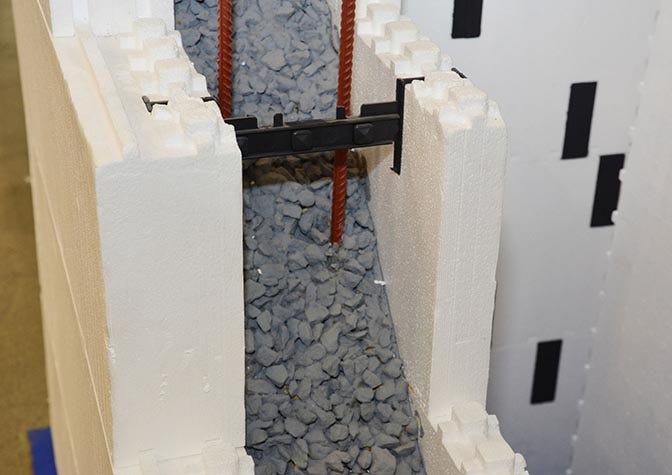Busting These 6 Myths About Insulated Concrete Forms (ICF)

Insulated concrete forms (ICFs) have been around since the 1940s, but they’ve only been gaining massive popularity today. Because of the slew of advantages ICFs present, many construction project management teams have made this innovative material a favorite on construction sites.
However, there are still some building owners and homeowners who are wary of using ICFs. This is because of the myths and misconceptions surrounding the material. In this article, we bust these myths in hopes of enlightening more people.
6 Insulated Concrete Form Myths
Myth #1: ICFs are just meant for residential walls.
This was true, but not anymore. Today, ICFs feature monolithic concrete cores and are being used in a plethora of commercial buildings, like schools, theaters, warehouses, military projects, and even high-rise buildings.
Another trend growing is using ICFs for houses being installed from footings to the roof. Any wall that can be built with cast-in-place concrete, CMU, tilt-up, or wood can be done with ICF. As a matter of fact, the number of above-grade ICF construction is increasing. Add to that the vast array of wall core thicknesses and means of exterior finish systems available. There is virtually no height limit to an ICF building.
Myth #2: ICFs are too expensive.
Because ICFs offer excellent thermal protection and sound reduction, many people assume that it’s expensive. On the contrary, ICFs are a relatively cost-effective building material, a notable benefit of this material.
With effective task management software and the incorporation of ICFs into the setting process of foundations and walls, your project would require about 10% less concrete. Plus, ICFs are often pre-assembled when delivered to the site. According to Green Garage, they scrape off a few inches of thickness, increasing savings on materials by about 25%.
On the other hand, the increase in costs would come from labor. Unlike traditional methods that need a relatively basic skill level, ICF construction requires specialized labor.
To know more about the advantages and disadvantages of ICFs, check out our article “What Are The Pros And Cons Of Using Insulated Concrete Forms (ICF)?”
Myth #3: Installing ICFs is complicated and blowouts can happen.
Like with every construction technique, material, and tool, you’ll need proper training to master using them. If you haven’t worked with ICF before, of course, you would have a difficult time using it for the first time.
But the truth is that modern pieces are even easier to with than wood. They usually come pre-assembled and have interlocking mechanisms the make it reasonably straightforward to use and adhere to building code requirements. Other than that, it requires less human power. So, if you are managing construction projects that use ICFs, you will see a boost in efficiency.
Another concern builders have is blowouts. When forms fold and allow wet concrete to spill out, it’s usually because workers skipped a few vital steps. If they correctly follow the means and methods, blowouts will almost never happen.
Myth #4: You can’t downsize an HVAC system when using ICFs.
Some HVAC contractors are reluctant or refuse to downsize systems when they hear that ICFs are in place. Unfortunately, not getting the correct sized system is a missed opportunity to save money.
One reason HVAC contractors refuse downsizing is protection. They don’t want their customers telling them that the building is too hot or too cold because the system cannot handle extreme loads at peak seasons. This often leads them to oversize the system rather than rightsizing them.
Another reason is that energy modeling programs may not recognize an ICF wall’s real-world performance. The output from these models is based on a nominal R-Value’s input and assumes higher air leakage rates. However, R-Value is not the only determinant of the in-situ performance of a wall. Check and make sure that the energy model in use considers that the IFC walls can significantly reduce HVAC load.
By downsizing the HVAC system, building owners can save on initial costs and reduced operating costs. If the system remains oversized, you won’t be able to take advantage of the airtight thermal mass wall.
Myth #5: ICFs don’t hold well in a natural disaster.
One of the major benefits ICFs have is improved structural integrity of walls. Once the concrete around the ICF hardens, it strengthens the walls and decreases its vulnerability to horizontal and vertical forces. More than that, ICFs allow you to insert rebar reinforcements, adding another layer of durability and strength.
Some ICFs, such as Nexcem’s forms, are even said to protect people from an F5 tornado. So, an underground safe bunker is not the only thing that can protect families from natural disasters. ICFs have that ability as well, as they can withstand 402 kph winds.
Myth #6: ICFs don’t look physically appealing.
Plenty of people are under the impression that ICF walls are visible and, therefore, ugly. Contrary to this notion, homes by ICF construction look just like any ordinary house. Builders can finish the outer surface with vinyl, stone, brick, or even wood siding. On the inside, it can feature a number of creative designs and architectural shapes.
While there may be some minute differences, such as marginally deeper window sills, they are overshadowed by ICF’s benefits.
9 Tips On Working With ICFs
Tip #1: Choose the right alignment and bracing system.
Bracing and alignment systems are vital in ICF construction. Without the proper system, you might find that a wall is not level and straight. Although it may be tempting to DIY a scaffolding and bracing system to save money, it will cost you more in the end. Some ICF manufacturers recommend specific systems that work well with their products.
Tip #2: Follow the design guides.
As with anything on a construction site, a lot can go wrong if something is not done correctly. So, use the design guides that often come with ICFs. If you follow them, you can make the jobs of the engineering and construction teams easier.
The previous tip is an example. A design guide will have recommendations of reinforcing requirements for different building types. This simple aid can save you money from over-designing.
Tip #3: Pay attention to the roofline.
To take advantage of the ICF wall’s thermal feature, the continuity of air barrier and insulation must be correct at the connection point to the roof. Designers and builders often neglect to check on this detail, and it compromises the thermal envelope.
Tip #4: Use the proper fasteners.
Again, we’ll say how critical instructions and the proper materials are. Like bracing, the appropriate fasteners are crucial in ICF construction as they hold practically everything together. When attaching to an ICF, make sure you don’t skimp out on the proper fasteners — the interior and exterior finish supplier usually recommends this.
There are different kinds of fasteners suited for different kinds of ICF. For example, plastic-webbed ICFs work well with a sharp, course-threaded screw and metal-webbed ones may need a self-taping screw. Additionally, particular ring nails and screws work better indoors than outdoors.
Tip #5: It can be challenging to work on corner windows.
Designs with corner window units can be tough to work on because they require extensive detailing like some cantilever action for the rebar as there is no corner post. Also, corner window units may support metal and wood framing, but they are not strong enough to handle the weight of concrete.
Tip #6: Don’t overcomplicate ICF construction.
Earlier in the article, we busted the myth that ICF construction is complicated. A major part of this is the lack of skill in working with ICF material. But also, structural engineers often view ICF construction as a complex building system, therefore overcomplicating it. But in reality, it’s a rather simple process.
Tip #7: Be careful when vibrating.
Blowouts rarely happen with ICFs, but strong foam-based forms are known to experience during the vibrating stage of concrete pouring. To evenly spread the concrete and not damage the forms, experts recommend using a small-diameter or “pencil” vibrator.
Another ICF installer technique is removing the blade from a reciprocating saw and using the saw to vibrate and spread the concrete gently.
Tip #8: Use subcontractor scheduling software
ICF construction already impressively enhances efficiency on a work site. But pair that with online project management software and you’ll be able to manage resources, the crew, and the whole project.
Project management software helps you stay on top of things. With it, you can easily schedule jobs and manage tasks. You can even remotely track and collaborate with your team in real-time, even if you are not on-site together. Plus, the ability to store and share documents on the cloud makes collaboration even better.
Are you a concrete contractor looking for effective subcontractor scheduling software? Use Pro Crew Schedule’s Concrete Contractors Software. Sign up today and get a free 30-day trial with all its features and no strings attached. Request a demo here.
